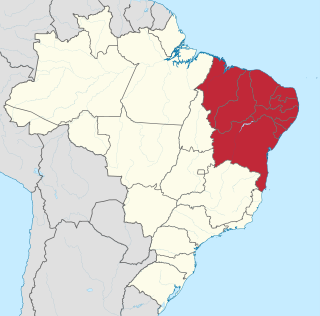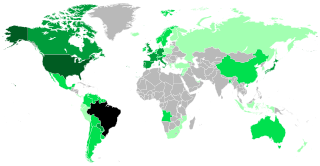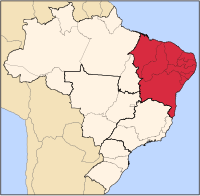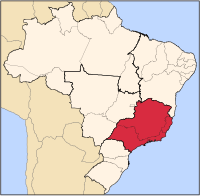
The country of Brazil occupies roughly half of South America, bordering the Atlantic Ocean. Brazil covers a total area of 8,514,215 km2 (3,287,357 sq mi) which includes 8,456,510 km2 (3,265,080 sq mi) of land and 55,455 km2 (21,411 sq mi) of water. The highest point in Brazil is Pico da Neblina at 2,994 m (9,823 ft). Brazil is bordered by the countries of Argentina, Bolivia, Colombia, Guyana, Paraguay, Peru, Suriname, Uruguay, Venezuela, and French Guiana.

Paraná is one of the 26 states of Brazil, in the south of the country. It is bordered in the north by São Paulo state, in the east by the Atlantic Ocean, in the south by Santa Catarina state and the province of Misiones, Argentina, and in the west by Mato Grosso do Sul and Paraguay, with the Paraná River as its western boundary. It is subdivided into 399 municipalities, and its capital is the city of Curitiba. Other major cities are Londrina, Maringá, Ponta Grossa, Cascavel, São José dos Pinhais and Foz do Iguaçu. The state is home to 5.4% of the Brazilian population and generates 6.2% of the Brazilian GDP.

In Brazil, Pardo is an ethnic and skin color category used by the Brazilian Institute of Geography and Statistics (IBGE) in the Brazilian censuses. The term "pardo" is a complex one, more commonly used to refer to Brazilians of mixed ethnic ancestries.

Cuiabá is the capital city of the Brazilian state of Mato Grosso. It is located near the geographical centre of South America. Also, it forms the metropolitan area of Mato Grosso, along with the neighbouring town of Várzea Grande. The city's name is an indigenous Bororo word meaning 'arrow-fishing', The city was founded in 1719, during the gold rush, and it has been the state capital since 1818. The city is a trading centre for an extensive cattle-raising and agricultural area. The capital is among the fastest-growing cities in Brazil, followed by the growth of agribusiness in Mato Grosso, despite the recession that is affecting Brazilian industries. Cuiabá was one of the host cities for the 2014 FIFA World Cup.

The Northeast Region of Brazil is one of the five official and political regions of the country according to the Brazilian Institute of Geography and Statistics. Of Brazil's twenty-six states, it comprises nine: Maranhão, Piauí, Ceará, Rio Grande do Norte, Paraíba, Pernambuco, Alagoas, Sergipe and Bahia, along with the Fernando de Noronha archipelago.

The Brazilian Highway System is a network of trunk roads administered by the Ministry of Transport of Brazil. It is constructed, managed and maintained by the National Department of Transport Infrastructure (DNIT), federal agency linked to the Ministry of Infrastructure, and the public works departments of state governments.

Brazil is divided into several types and levels of subdivisions.

White Brazilians refers to Brazilian citizens who are considered or self-identify as "white", typically because of European ancestry, or Levantine ancestry from Lebanon and Syria.

Brazilians are the citizens of Brazil. A Brazilian can also be a person born abroad to a Brazilian parent or legal guardian as well as a person who acquired Brazilian citizenship. Brazil is a multiethnic society, which means that it is home to people of many ethnic origins, and there is no correlation between one's stock and their Brazilian identity.
Brazilian censuses do not use a "multiracial" category. Instead, the censuses use skin colour categories. Most Brazilians of visibly mixed racial origins self-identify as pardos. However, many White Brazilians have distant non-white ancestry, while the group known as pardos likely contains acculturated Amerindians. According to the 2010 census, "pardos" make up 82.277 million people or 43.13% of Brazil's population.

Brazilian society is made up of a confluence of people of Indigenous, Portuguese, and African descent. Other major significant groups include Italians, Spaniards, Germans, Lebanese, and Japanese.

Dutch Brazilians refers to Brazilians of full or partial Dutch ancestry. Dutch Brazilians are mainly descendants of immigrants from the Netherlands.

Brazil had an official resident population of 203 million in 2022, according to IBGE. Brazil is the seventh most populous country in the world, and the second most populous in the Americas and Western Hemisphere.
Global Village Telecom (GVT) was a Brazilian telecommunications company that offers services on landline telephone, broadband for both consumer and business, Pay TV and voice over IP. GVT has been in the market since the end of 2000. GVT today operates under the Vivo brand.

Código de Endereçamento Postal is the Brazilian postal code system commonly known as CEP. Introduced in 1972 as a sequence of five digits, it was expanded to eight digits in 1992 to allow for more precise localization. The standard format is "nnnnn-nnn".

Events from the year 2004 in Brazil.

Events in the year 2000 in Brazil.

The following lists events that happened in the year 1989 in Brazil.
Proposals for the creation of federative units in Brazil are currently under discussion and in different stages of processing in the National Congress. The creation of 18 new states and three new federal territories were officially proposed, which would bring the total number of federative units to 48. The region with the largest number of federative units would be the North region, while the South region would be the only one with a new federative unit. The states with the most advanced stage of creation are Gurgueia and Maranhão do Sul both in the Northeast region.




















